
Canjica is a white variety of corn typical of Brazilian cuisine. It is mostly used in a special kind of sweet popcorn and in a sweet dish also named "canjica", a popular Festa Junina dish. [1]

Canjica is a white variety of corn typical of Brazilian cuisine. It is mostly used in a special kind of sweet popcorn and in a sweet dish also named "canjica", a popular Festa Junina dish. [1]

Brazilian cuisine is the set of cooking practices and traditions of Brazil, and is characterized by, European, Amerindian, African, and most recently Asian influences. It varies greatly by region, reflecting the country's mix of native and immigrant populations, and its continental size as well. This has created a national cuisine marked by the preservation of regional differences.
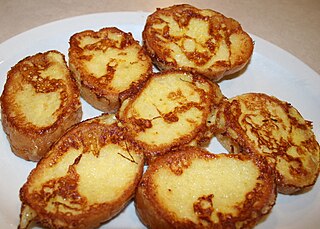
French toast is a dish made of sliced bread soaked in beaten eggs and typically milk, then pan fried. Alternative names and variants include "eggy bread", "Bombay toast", "gypsy toast", and "poor knights".

Paçoca is a candy made out of ground peanuts, sugar and salt. Some recipes also add flour, such as corn flour, oat flour or cassava flour. It is typical of the Brazilian Caipira cuisine and most present in the countryside of southeastern states of São Paulo and Minas Gerais, being either manufactured or home-made. It is also very common during the Festa Junina, an annual festivity that celebrates the caipira lifestyle. It is known for its distinct dry texture and sweet taste, and is one of the most beloved Brazilian candies.

Pamonha is a traditional Brazilian food. It is a paste made from boiled sweet corn in coconut milk, typically served wrapped in corn husks.
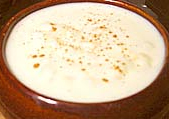
Canjica, mugunzá or mungunzá is a Brazilian sweet dish, associated with winter festivals, which in Brazil is in June.

Cachupa is a famous dish from the Cape Verde islands, West Africa. It is a slow-cooked stew of corn (hominy), beans, cassava, sweet potato, fish or meat, and often morcela. Referred to as the country's national dish, each island has its own regional variation. The version of the recipe called cachupa rica tends to have more ingredients than the simpler cachupa pobre.
Pastel is the Spanish and Portuguese word for pastry, a sugary food, and is the name given to different typical dishes of various countries where those languages are spoken. In Mexico, pastel typically means cake, as with Pastel de tres leches. However, in different Latin American countries pastel can refer to very different sugary dishes, and even to non-sugary ones as well. In some places, like Brazil, a pastel can refer to both a sugary and non-sugary food, depending on the filling used.

Water chestnut cake is a sweet Cantonese dim sum dish made of shredded Chinese water chestnut. When served during dim sum, the cake is usually cut into square-shaped slices and pan-fried before serving. The cake is soft, but holds its shape after the frying. Sometimes the cake is made with chopped water chestnuts embedded into each square piece with the vegetable being visible. One of the main trademark characteristics of the dish is its translucent appearance.

Curau is a Brazilian sweet custard-like dessert made from the pressed juice of unripe maize, cooked with milk and sugar.

Chatti pathiri is a layered pastry made in the Malabar region, of Kerala, India. It is made in both sweet and savoury variations. The dish is similar to the Italian lasagna, but instead of pasta, pastry sheets / pancakes made with flour, egg, oil and water are used. The filling depends on the variation desired. The sweet ones are made with sweetened beaten eggs, nuts and raisins, seasoned with cardamom. The savoury ones are made with traditional meat filling used in making samosas or savoury puffs. The flour is kneaded into soft dough and rolled into thin pancakes. These pancakes are soaked in milk to soften them and arranged in layers. The fillings are added between these layers. Once layered, it goes in for baking at 180 degrees for approximately 20 minutes.

Puchero is a type of stew originally from Spain, prepared in Yucatán, Mexico, Argentina, Paraguay, Uruguay, Perú, south of Brazil, the Philippines, and Spain, specifically the autonomous communities of Andalusia and the Canary Islands. The Spanish word "puchero" originally meant an earthenware pot, before being extended to mean any vessel, and then the dish cooked in it.
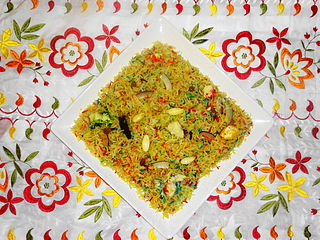
Zarda is a traditional boiled sweet rice dish, native to the Indian subcontinent, made with saffron, milk and sugar, and flavoured with cardamoms, raisins, pistachios or almonds. The name Zarda comes from Persian word 'zard' زرد meaning 'yellow', hence named since the food coloring added to the rice gives it a yellow color. Zarda is typically served after a meal. In the Indian subcontinent, zarda was and still remains a popular dessert on special occasions such as weddings. It is very similar to Sholezard, an Iranian dessert.
Frejon is a coconut milk and bean soup which is eaten especially during Holy Week by a selection of Christians, mostly Catholics, across the world. Countries where Frejon is popular include Brazil and Nigeria, and also Sierra Leone on Good Friday, or for functions such as weddings. Because dairy foods and flesh meat are strictly forbidden on Good Friday, this dish is a suitable accompaniment to non-dairy foods such as fried fish and peppered snail.

Bolinho de chuva is a dessert both in Portugal and Brazil. It is made from flour, eggs, milk and baking powder or baking soda. The doughnuts are deep-fried and sprinkled with cinnamon and sugar. The name refers to the raindrop shape the batter makes when it hits the oil and to the idea that it is a good rainy day project to make the dish.
Katemak is an Indonesian traditional dish from the East Nusa Tenggara Province. To prepare this dish, beef is boiled with sweet potatoes, sweet corn and some green vegetables such as cassava leaves and papaya leaves to make a soup. Some spices such as the small red onions, garlic and red chillies are added during cooking.
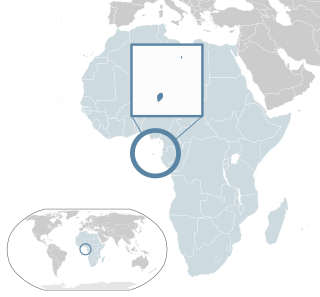
Santomean cuisine comprises the cuisine, dishes and foods of São Tomé and Príncipe, a Portuguese-speaking island nation in the Gulf of Guinea, off the western equatorial coast of Central Africa. The country consists of two archipelagos around the two main islands: São Tomé and Príncipe, located about 140 kilometres (87 mi) apart and about 250 and 225 kilometres, respectively, off the northwestern coast of Gabon.
Pumpkin in coconut cream, known in Thai as fakthong kaeng buat, is a traditional Thai sweet. The dish has been eaten for decades and is one of the most famous local sweets.
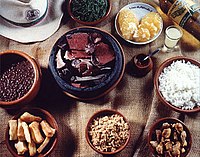 |
| Part of a series on |
| Brazilian cuisine |
|---|
| Types of food |
| See also |